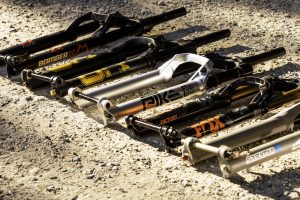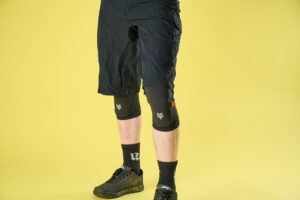The latest V4 Trek Top Fuel aims to find the sweet spot between cross-country pace and trail riding confidence by saving weight and adding adjustability. The result is a whisker away from perfection.
I’m a huge fan of Trek’s high-octane Top Fuel 9, and the latest version is the best yet – but it could be even better
I was a big fan of the previous alloy Top Fuel from Trek, as were Danny and Alan when they tested the last Top Fuel 8, and this latest version takes its “poppy, playful nature” (MBR’s words, not Trek’s) in an even more trail oriented direction, while also losing weight from its frame. All in the quest to make it the ultimate down-country ripper. Spoiler alert: the stock bike is great, but the fact that Trek could have easily delivered an even more capable, better value bike is frustrating. Read on to find out why.

The new Trek Top Fuel is lighter, but it’s still no flyweight.
Trek Top Fuel gen 4 need to know
- New lighter, smoother-riding frame frame with neater storage hatch and four-way shock adjust
- Slightly tweaked geometry makes a great feeling bike even more enjoyable on fast, technical trails
- Too heavy for XC, but light enough to be a very capable short travel trail bike
- You only get 110mm of actual rear travel rather than the claimed 120mm, but the ABP system creates an excellent, tenaciously-grippy-but-efficient-pedalling balance for all round performance
- Sorted trail components (aside from weak brakes) but expensive for what you get on an alloy frame
- Easily extended shock stroke makes a great suspension system brilliant, but you’ll need to upgrade the basic fork to match
- Find out more about the new Trek Top Fuel along with a range overview in our news story here

ABP places the seatstay/chainstay pivot concentric to the rear axle to help suspension performance under braking.
Frame and geometry
The new Top Fuel looks the same as every Trek trail bike in recent memory, even if it’s not as sharply sculpted as the longer travel Fuel EX, and you still get the signature Active Braking Pivot layout. This means the seatstays and chainstays pivot around the rear axle, so the suspension is more independent of braking forces.

That rocker link drives the trunnion mount shock to give either 120mm or 130mm depending on how you set the shock up.
It may look the same, but the latest Top Fuel gets a welcome weight loss – the whole tube set is slimmer and 150-200g lighter (depending on size) on both this 3.7kg alloy frame and the 2.7kg carbon version. Separate alloy linkages (rather than a one piece magnesium block) also allow more flex.

The lower shock mount gives two progression rates, and two geometry settings, with the rearward hold being the most progressive.
Adjustable geometry
The hi/lo flip-chip at the shock base also gets fore and aft positions to change progression from 14 to 19%, as well as tweak the geo and BB height. Crucially you can extend shock stroke from 50 to 55mm with a simple spacer removal and capture bolt swap to give 130mm of rear travel. You can even run a piggyback air shock if you want, and the frame is strong enough, and certified, to run a 140mm fork. The Top Fuel is also MX/Mullet happy in the higher flip-chip position, with the S frame size getting 27.5in wheels at both ends as standard – other sizes come as full 29ers.

The Trek Top Fuel still benefits from internal frame storage, even if the hatch is still on the small side.
Internal storage
The hatch and opening for the internal frame storage and the internal cable routing have been tidied up, and you get a new higher capacity BITS bag to slide into the down tube. The opening is still quite tight though, and you only get one bottle cage mount, plus an ‘accessory mount’ under the top tube. There’s no ‘Knock Block’ steering limiter on the short head tube however, so bike park X-ups are back on the menu if your skills date from the days when Skyway wheels were the stuff of dreams.

Trek has got rid of the Knock Block steering limiter on the latest generation Top Fuel.
Trek has reduced the seat tubes lengths, giving more clearance for longer seat posts in a chunky 34.9mm diameter. Or the opportunity to size up or down if the middling reach numbers don’t suit you. While there’s no XXL size anymore, the new XL is nearly the same reach, so the gap is now where XL used to be.

Another shot of that ABP link on the Trek’s dropout.
While reach of the M/L size I tested is effectively the same, just over 0.5º is added to the seat tube angle for a more centralised position. Half a degree is taken off the head tube angle, 6mm off the BB height and longer rear centres are added to the M/L, L and XL bikes to increase stability slightly.

SRAM’s slick GX wireless AXS drivetrain can be found on the Top Fuel 9.
Components
The Top Fuel 9 (tested here) is the best specced bike of the alloy frame range and gets SRAM X0 T-Type wireless gears to make the most of the UDH rear end. SRAM Level brakes are too weak for a bike this fast and fun though, despite rocking four pistons. Using a Rhythm, rather than Performance-spec Fox 34 fork also adds weight to a hefty spec list that already includes 2kg worth of Bontrager wheels. It means you can’t upgrade the simple GRIP damper easily either, which becomes a big issue if you extend the rear shock travel – more on this in a moment.

More short travel trail than down-country, the Top Fuel’s a really capable bike considering its meagre travel.
Ride and handling
It’s a sign of how well the Top Fuel rides in stock format that it took me several stages of arguably the roughest enduro race in the UK – the Ard Rock Enduro – to realise I wasn’t getting full travel. Even with the big bottom-out bumper reducing rear wheel movement to 110mm, the Trek still charged into serious boulder sections and came out the far side in control and online. There’s plenty of support in the mid-stroke for loading feet through berms or pumping backsides too. The more compliant frame, trunnion mount shock and Bontrager Gunnison Pro (previously XR4) tyres also give a very sensitive, high traction ride on loose, baked ruts and random root sections.

The low front end makes it tricker to pull off moves like this, but it also keeps the nose sniffing the ground on steep climbs.
Unsurprisingly the high weight of wheels and complete bike is obvious on long climbs and under sudden accelerations. Especially compared to more XC-biased bikes in this short travel category, like the 2kg lighter Epic Evo. If you’re hustling between turns and trees, rather than seeking horizons, the Top Fuel feels much more eager, responsive and rewarding to push the pedals on than lifting it over stone walls between stages would suggest. That’s partly a product of the fast reacting freehub, impressively efficient-feeling suspension, and excellent traction/flow of the suspension. But even in its most trail-biased incarnation to date, there’s an unmistakable velocity vibe to the latest Top Fuel.
The short 110mm head tube and slightly steeper seat angle also nailed the bike’s nose down to keep it on target and make the most of the excellent traction on crux-climbing moves. Obviously that lower front end does make it harder to manual or hoik off drops. It also puts more pressure through the already firm (rather than forgiving) grips and a fork that could only handle so much hammer before my hands really knew about it. That’s the only potential vice in ‘play bike’ terms on an otherwise totally intuitive handling package that never put a wheel wrong for me, whether up, down, or along wherever I rode it.

Unlocking more travel from the shock unleashed the Trek’s inner beast, but also highlighted shortcomings with the fork and brakes.
However, things got complicated when Trek encouraged me to open up the rear shock, whip out the travel spacers, trim the bottom-out bumper and unleash its full 55mm stroke / 130mm travel potential. Not because it’s a hard job – it literally takes five minutes (as long as you’ve either got shorter plate retainer bolts ready or a sharp saw to cut the originals down) – but because of what it does to the bike.

Suffice to say, extracting the full potential from the latest Top Fuel 9 could involve some pricy upgrades.
At the back end, the already impressive suspension steps up to genuine superstar status. A richer mid-stroke and flutteringly flawless ground connection matches bikes like the Evil Following, Yeti SB120, Norco Optic, and Pivot 429 etc. It also shames a lot of longer travel bikes in terms of speed and control while feeling more alive and rewarding at the same time. You’re not getting any increase in weight or reduction in pedalling efficiency either, so it’s a win-win.

Still a total ripper, but the latest Trek Top Fuel could be even better.
Unfortunately that jump to warp speed seriously overwhelms the simple Fox fork and the weedy XC brakes, so making the upgrade will trigger some expensive upgrades straight away. Annoying when the bike is already pricey for the package, and it wouldn’t have taken much for Trek to have fitted suitable brakes and an upgradeable fork from the off.
Verdict
This leaves the Top Fuel gen 4 as a great short travel trail raver, that’s a noticeable improvement on one already loved by the MBR test team. An intuitively balanced all round over-achiever that hides its hefty weight well and goes a long way to excusing its high price once in the dirt. Unlocking the extra travel also unlocks some serious extra potential, but it's an expensive upgrade on a bike that's already no more than average value. And if you’re wondering why Trek doesn't just run the longer shock stroke as standard, my guess is that it would bring the Top Fuel too close to the 1kg heavier 150/140mm travel Fuel EX. I wouldn’t be surprised to see that happening soon though, with the gap between Top Fuel and 80mm travel Supercaliber being filled with a lighter, full time 120mm race bike.
















